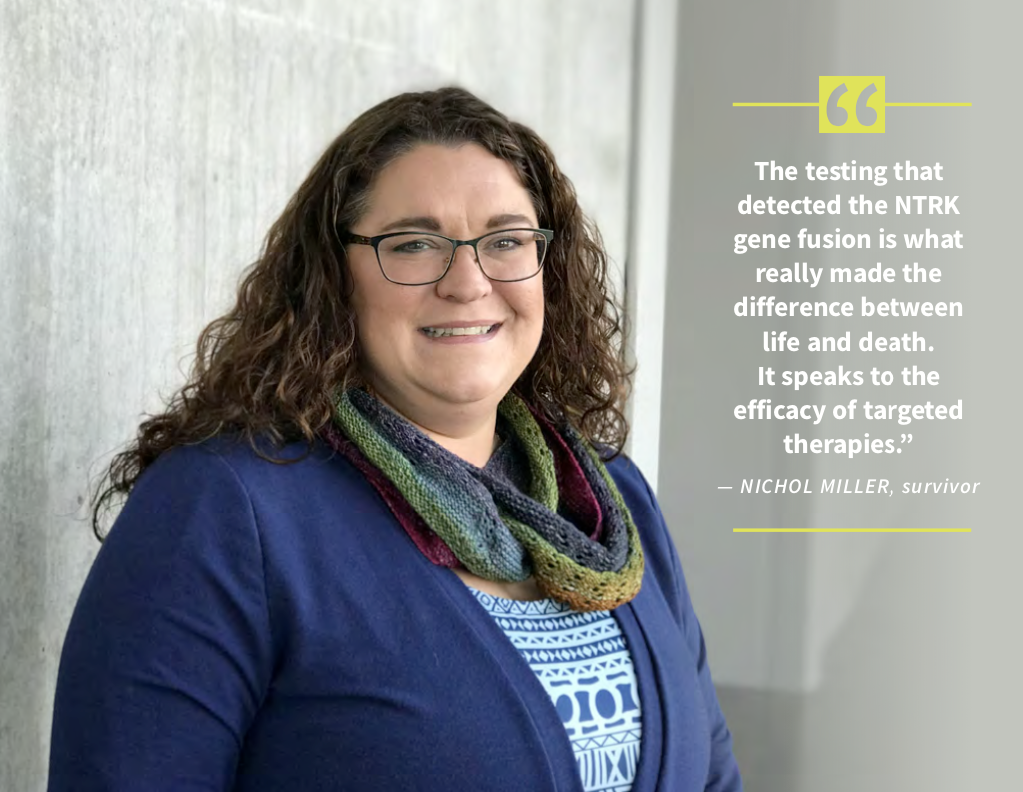Blowing a Fuse: Fighting NTRK Gene Fusions in Cancer
A new drug can break the circuit of cancer-causing effects that develop when certain genes fuse.
After Nichol Miller was diagnosed with a high-grade soft tissue sarcoma in her leg in the fall of 2014, she underwent broad-spectrum chemotherapy and surgery at Oregon Health and Science University Hospital, near her home in Portland. Neither treatment stopped the fast-spreading cancer.
Her physicians rechecked the results of the next-generation genomic testing that was conducted on her tumor samples. They discovered that her tumor had a rare mutation called NTRK gene fusion — and told her about a clinical trial opening in Denver for a drug targeting that abnormality. In March 2015, Miller was the first patient with such a fusion to enroll in the trial; by then, she was in a wheelchair and relied on supplemental oxygen to breathe because tumors filled 90% of her lungs.

"The testing that detected the NTRK gene fusion is what really made the difference between life and death,” says survivor Nichol Miller.
Within three days of starting the drug, a twice-daily pill, Miller could sit up and talk in complete sentences. A month later, she was off the oxygen; by six weeks, she could go horseback riding. Her scans have shown no evidence of cancer for the past three years, and she remains on the drug, now called Vitrakvi (larotrectinib). Unlike chemotherapy, Vitrakvi doesn’t cause many side effects — Miller has mild body aches once in a while, she says — so she can stay on the drug as long as it keeps her cancer at bay.
“The testing that detected the NTRK gene fusion is what really made the difference between life and death,” says Miller, 45, a mother of three teenagers who now travels throughout the country telling her story at cancer-related conferences. “It speaks to the efficacy of targeted therapies.”
The Food and Drug Administration approved Vitrakvi in November 2018 to treat adults and children with solid tumors of any type originating anywhere in the body if the patients have fusions in one of three NTRK (neurotrophic receptor tyrosine kinase) genes. It was the first drug on the market to target NTRK fusions and the second FDA approval based on the biological characteristics of tumors rather than their location in the body. The initial one was the immune-activating drug Keytruda (pembrolizumab), approved for patients with solid tumors characterized as microsatellite instability (MSI)-high or mismatch repair deficient. Tumors with these genetic abnormalities have trouble repairing their own DNA when it’s damaged.
An NTRK fusion occurs when a piece of the chromosome that contains a coding part of an NTRK gene splits off and connects to an unrelated gene on a different chromosome.
That sparks the production of a chimeric — or fusion — protein composed of uncontrolled TRK enzymes, which promote cancer growth. NTRK fusions are rare: A recent sampling of more than 13,000 tumors found the abnormality in just 0.31% of adult cancers and 0.34% of pediatric tumors. Each year, an estimated 5,000 patients receive this diagnosis. NTRK fusions appear in some common cancers, such as non-small cell lung, sarcoma and colon, as well as some rare cancers, including secretary breast carcinoma and cellular or mixed congenital mesoblastic nephroma.
NTRK fusions in cancer were discovered in the 1980s, and at first, oncology researchers feared they couldn’t be targeted with drugs. That’s because three NTRK genes play critical roles in the development and survival of nerve cells, raising the possibility that altering the genes could cause dangerous neurological side effects. But as researchers continued to study gene fusions, they realized those fears were unfounded.
“Gene fusions are unique to cancer cells,” says Dr. George Demetri, director of the sarcoma center at Dana- Farber Cancer Institute in Boston. That makes them ideal targets, because drugs designed to block the effects of protein that arises from gene fusions are unlikely to affect healthy tissues, he explains. The side effects reported during the Vitrakvi trials included mild fatigue, dizziness and digestive issues, but for the most part, “the drug is remarkably well tolerated,” Demetri says.
FINDING NTRK FUSIONS
Vitrakvi was approved by the FDA based on data from three studies involving 55 patients with NTRK fusions who had run out of treatment options. The drug produced a 75% overall response rate — the proportion of patients who responded partially or completely to the therapy — across a range of tumor types, including thyroid cancer, lung cancer and soft tissue sarcoma. Of those responses, 39% lasted a year or longer.
In May 2019, researchers presented updated results from two of the Vitrakvi trials. At that point, 83 adults had received the drug, and among the 74 patients who could be evaluated, the response rate was 76%.
Children fared even better. Of 34 pediatric patients who could be evaluated, the overall response rate was 94%. Most of the children had stayed on the drug for more than
a year, with some still taking it two years after the trial began.

Kayley Leeds says the drug Vitrakvi has given her son, Ashton, “his life back” after thyroid cancer. Here, Leeds and her husband, Shayne, are pictured with their son.
Ashton Leeds was eight years old and battling stage 4 thyroid cancer when he was admitted into a clinical trial of Vitrakvi at Seattle Children’s Hospital. Ashton, who is from Claresholm, Alberta, received his diagnosis in the fall of 2014, when he was just 5, and was treated with surgery in Toronto and then with radioactive iodine at a children’s hospital in Calgary. But his cancer had spread to his lungs and kept coming back, and his doctors ran out of treatment options by early 2017.
Then Ashton’s mother, Kayley Leeds, got a phone call from a researcher who asked to test her son’s tumor samples and include the results in a database of rare tumors. She agreed. A few months later, she got a call informing her of Ashton’s NTRK gene fusion. Ashton’s doctors matched him with the clinical trial in Seattle.
Ashton started the drug in July 2017, and within two months, most of his tumors disappeared. He has a few spots in his lung, but “he’s able to play soccer again and run and play with his friends,” his mother says. “It has given him his life back.”
Several tools can detect NTRK fusions in tumor samples. Reasonably inexpensive immunohistochemistry tests can identify proteins made by fused genes, and other laboratory assays can spot abnormal genes and chromosomes. Many oncologists favor more comprehensive next-generation sequencing (NGS) of tumor tissue, which can detect several gene alterations, including NTRK fusions, in a single test.
“These days, with advances in technology, we can check more than 400 cancer-related genes in one shot, including NTRK,” says Dr. Shumei Kato, a medical oncologist with Moores Cancer Center at University of California, San Diego Health and an assistant professor of medicine at the UC San Diego School of Medicine. If an NTRK fusion is detected, “that can be life-changing for certain patients,” Kato says.
The advantage of using NGS testing over other methods, he adds, is that it may turn up abnormalities in other genes, such as ROS1 and ALK in lung cancer, which can be targeted with different drugs.
Dr. Benjamin Levy, clinical director of medical oncology at Johns Hopkins Sidney Kimmel Cancer Center at Sibley Memorial Hospital in Washington, D.C., believes that most patients with lung cancer should have NGS testing because of the potential of targeted drugs like Vitrakvi to improve their prognosis. But arranging this for every patient can be challenging: Sometimes there isn’t enough tumor tissue collected during a biopsy to complete NGS testing, he says, or physicians become overwhelmed by the logistics involved in ordering the tests.
“That has to change,” Levy says, adding that patients should insist on NGS testing of their tumors: “Now we have these wonderful therapies that are emblematic of precision medicine.” To help oncologists choose therapies based on the results of NGS tests, many cancer centers have put together molecular tumor boards, groups of physicians who work together to interpret the data and recommend personalized treatments based on the results.
BATTLING DRUG RESISTANCE
Drug developers are working on the next generation of NTRK-inhibiting drugs, which could help patients who initially respond well to Vitrakvi but whose cancers then become resistant. One of those drugs, Loxo-195, was designed to counteract a common mechanism of resistance called TRK kinase mutations. An ongoing clinical trial of the drug is recruiting children and adults with advanced, NTRK fusion-positive solid tumors that have stopped responding to Vitrakvi.

Acra Samuels, whose liver tumors responded extremely well to Vitrakvi, walks near her Montana home with her husband, Chris, and their sons, Chase, Holden and Austin.
Acra Samuels obtained both Vitrakvi and Loxo-195 on a trial basis, the first drug in 2016 and the follow-up medicine a year later, when tumors in her liver became resistant to Vitrakvi and spread throughout her abdominal cavity. “I had not been able to eat, I could hardly walk and there were tumors protruding from my abdomen,” says Samuels, who traveled from her home in Big Sky, Montana, to Dana-Farber for treatment. “It was clear I wouldn’t have long at all if there wasn’t another solution.”
One day after starting Loxo-195, Samuels started eating again; five days later, virtually all the tumors had receded. Samuels remains on the drug with no evidence of cancer in her body. Her only side effect is a bit of dizziness that prevents her from driving at night. “It’s nothing short of a miracle,” says Samuels, 48, a mother of three who owns a vacation rental business with her husband.
Data from an early trial of Loxo-195 reported in April showed a 34% response rate to the drug. Twenty patients had TRK kinase mutations, and nine had a complete or partial response. The three patients in the trial who grew resistant to Vitrakvi for other reasons did not respond to Loxo-195.
Patients can become resistant to targeted drugs in many ways, Kato says, which makes treating NTRK- fusion-driven cancers challenging. “Unfortunately, cancer can be smart,” he says. “Tumors create new mutations in NTRK that allow the cancer to survive.” Another potential problem: There are other NTRK aberrations, including amplifications, or abnormal increases in the number of copies of the gene. “We need to find out what role they play in cancer,” Kato says.
Other drugs in development could help patients who become resistant to Vitrakvi. For example, entrectinib targets NTRK fusions, as well as fusions in ROS1 and ALK that can drive cancer. Findings from a trial that included 54 patients with NTRK fusions showed a 57% response rate. Responses occurred across 10 tumor types, including lung cancers and sarcomas, and lasted more than 10 months, on average. The FDA is expected to decide whether or not to approve the drug by August.
One specific way that NTRK fusion-positive cancers become resistant to targeted treatments is by developing “solvent-front mutations,” which prevent the drugs from binding to TRK protein targets in cells. One drug in development, repotrectinib, inhibits these and other mutations that can emerge in patients taking drugs targeted at fusions in NTRK, ALK or ROS1.
About 75 patients with solid tumors that have ROS1, ALK or TRK fusions have been treated with repotrectinib in an ongoing phase 1 clinical trial, and early results presented in May were promising. Among patients with ROS1-positive non-small cell lung cancer who had experienced relapses after previous treatments, 44% responded to the highest dose of repotrectinib that was tested. The trial continues to enroll patients with any kind of NTRK- positive tumors.
Immunotherapy might also come into play in the treatment of tumors with NTRK fusions. Keytruda (pembrolizumab), for example, works by inhibiting PD-1, a “checkpoint” protein that normally prevents the immune system from recognizing and attacking cancer. Tumors that are MSI-high or have elevated levels of the protein PD-L1 — typically detected using an anti- body as opposed to gene sequencing — might be able to be treated with PD-1 inhibitors. A study published in January 2019 found that 23% of tumor samples with NTRK fusions also had high PD-L1 expression, leading the researchers to suggest that combining NTRK inhibitors with drugs like Keytruda may be a good option for patients who test positive for both tumor characteristics.
Keytruda, like Vitrakvi, typically produces minor side effects and is often well-tolerated. So, for patients who have NTRK fusions and MSI-high cancers, “we now have two terrific options,” Demetri says. It can be challenging to determine which drug to administer first, he adds, but as the oncology community gains more experience with these highly effective new drugs — and with NGS testing — physicians will become more adept at determining the most effective treatment plan for each patient, he says.
“NTRK fusions are really rare, so it’s something the average oncologist may not think about, but there’s a lot of value in looking for it,” Demetri says. Patients with the abnormality can skip traditional chemotherapy, which has harsh side effects and is rarely successful in NTRK-fusion- positive tumors, and go straight to drugs like Vitrakvi, he says. “(Targeted treatments) are extremely powerful and much better than chemotherapy in life-threatening diseases such as sarcomas,” he adds.

When the Daughter of a Pediatric Oncologist Receives a Cancer Diagnosis
October 14th 2021“We tried very hard, my daughter and I, to have a daughter-father relationship, not a daughter-doctor relationship,” said Dr. Michael Weiner on this episode of the “CURE® Talks Cancer” podcast, in which he discussed his career, his own cancer journey and his daughter’s diagnosis.
Listen